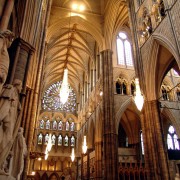How To Design The Perfect Religion
The idea of designing a religion is a fascinating one, due partly to the selection of motivations for doing so. One could hope to design a religion that would become widely popular and financially benefit its inventor. One could design a religion for the purposes of making a point: to tear apart the fabrication once a number of people had been convinced. One could even do it in an attempt simply to better the world: replacing the older, sometimes malevolent religions with something more placid that corresponded to contemporary values.
But what qualities would the perfect religion have? One might assert that no religion could be perfect, for if it were perfect, it wouldn’t be worthy of the name religion. But we’ll state that in this case the perfect religion is one which has maximum chance of success: one which will convince the greatest number of people possible of its teachings. Such a religion would have to inspire the largely irreligious to become more involved, and convert many away from other religions.
The easier way to design a religion would be to take one of the major religions and deviate from it, changing certain aspects. This would have the advantage of affiliation, perhaps making this method more successful because many people already understand much of the new religion. Indeed this process happens in many religions across the world anyway. Consider how religions such as Christianity and Islam, which have some vicious sentiments in their texts, have in some cases evolved into more tempered forms. Christianity shows this particularly well, with many organisations considered the softer form of the religion, cherry-picking what they want and leaving nearly everything open to interpretation. In many ways this cherry-picking process could act as a guide for designing a religion; it shows where people want to take their religion, but perhaps just need the leadership to do so. It seems unusual then, that nobody has though of rewriting the Bible, cutting out the sections which by today’s general modal standard are reprehensible.
The harder, though possibly more effective method, is to derive the perfect religion from basic principles. It seems likely that many of the necessary elements could be determined by this approach, but this method may omit something vital which does not occur to the designer.
Let’s start with the obvious. Religions have a legacy of providing answers to seemingly intangible questions; they placate the brain and stop it asking more than it can answer. A new religion would need to both provide satisfactory and comprehensible answers to difficult questions, and be able to withstand the intellectual whip of modern science. The easiest way to achieve this would be to move the goalposts far beyond this universe into an unprovable domain of emotion and spirituality.
What about morality? Strictly speaking morality needn’t accompany religion, it just seems to have happened. But if incorporating the sense of guidance into a religion will help it succeed then it goes in. It would probably be a case of merging present-day moral philosophy with the edge of conservatism that so often accompanies religion, and possibly something fluffy like conservationism. There is probably also need for the authority that tends to accompany the morality: emanating both from the divine figure and the religious leaders.
Then there’s the sense of community. People who are part of religions often want a support network: sometimes to act as a mass therapy session for the difficulties of life, othertimes to give an ego-boost. How would this be achieved? This would be where structure and formality to the religion take their place, with weekly gatherings and ceremonies, each reinforcing the familiarity and comfort of it all.
Ultimately this quest is both fascinating and, in order to do it properly as opposed to the quick brainstorm here, extremely time consuming. It could involve several moral qualms on behalf of the architect, which may need to be reconciled or resolved well.


This is an example of what I would say would be the start to a perfect religion. It encompasses the tiny bits of pieces all together and has nothing to really disprove it except that it seems like a ton of work just for one thing:
http://whywontgodhealamputees.com/forums/index.php/topic,21751.msg484309.html#msg484309